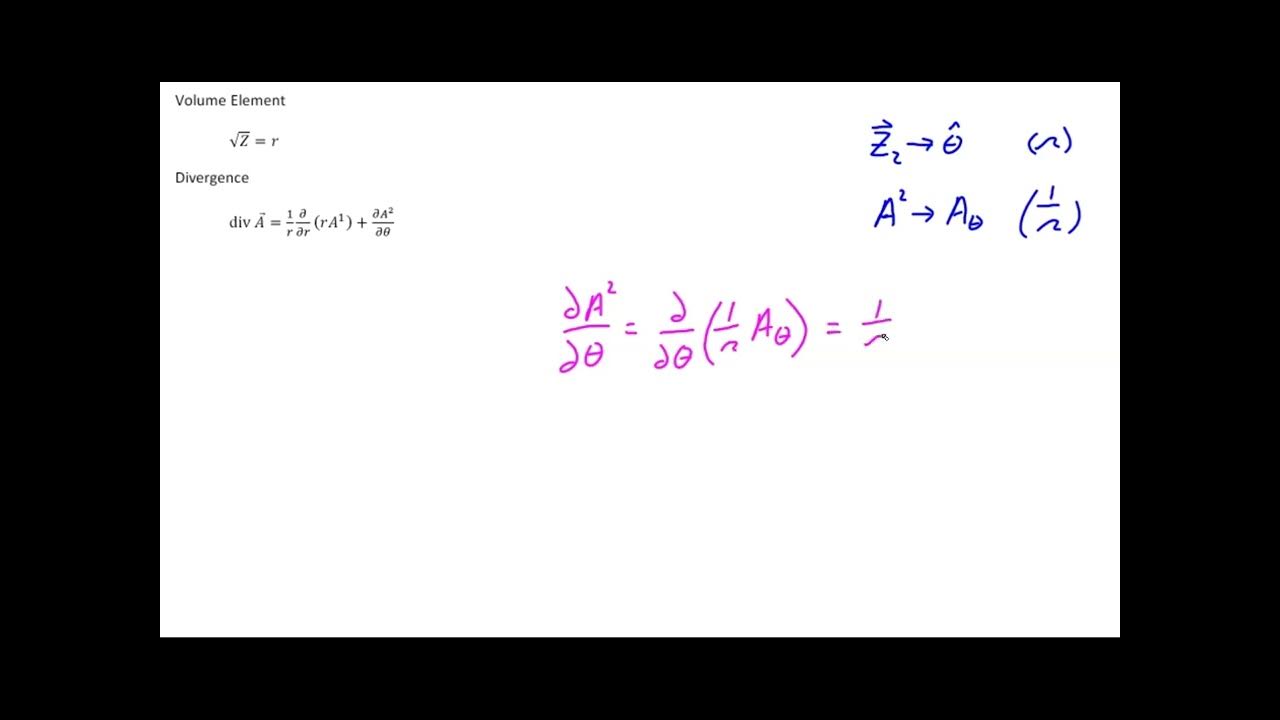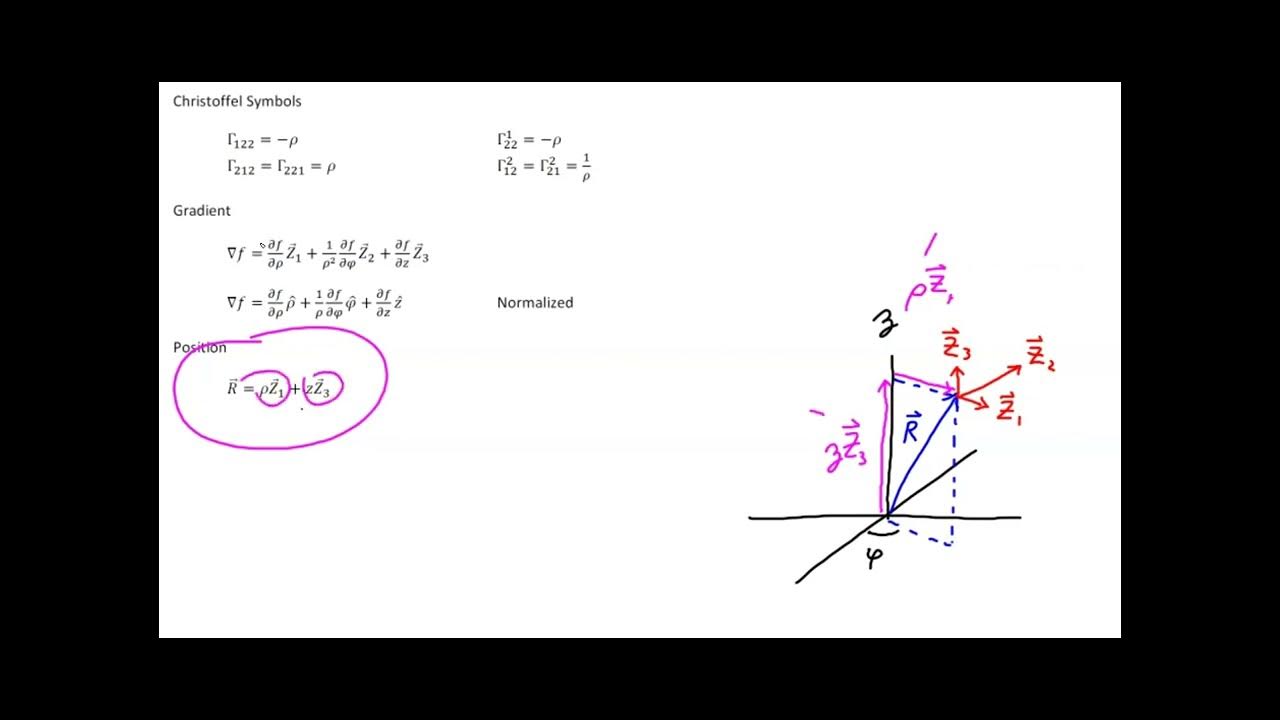Video 25 - Dot Product Examples
TLDRThis video delves into the application of invariant expressions for the dot product across various coordinate systems in tensor calculus. It revisits Cartesian coordinates, then moves to affine, plane polar, cylindrical, and spherical polar coordinates, explaining the simplifications due to orthogonality and the role of metric tensors. The script also clarifies the difference between tensor calculus representations and normalized forms commonly found in mathematical literature, providing insights into adjusting basis vector lengths and their impact on vector components.
Takeaways
- 📚 The video continues the discussion on tensor calculus, specifically focusing on the dot product in various coordinate systems.
- 📐 In Cartesian coordinates, the dot product is invariant and can be expressed using any of the four standard forms, which was thoroughly analyzed in a previous video.
- 🔍 The script simplifies the discussion of affine coordinates by highlighting that the dot product involving contravariant and covariant components is trivial across all coordinate systems.
- 📈 The challenge in affine coordinates lies in the inclusion of metric tensor terms, which requires iteration through all elements of the covariant metric tensor and combination with vector components.
- 📝 The metric tensor's symmetry simplifies expressions, as shown by the reduction of terms in the dot product formula for affine coordinates.
- 🌐 The script moves on to plane polar coordinates, emphasizing the orthogonal nature of the system, which results in only diagonal elements of the metric tensor being non-zero.
- 📊 For cylindrical polar coordinates, the script notes the orthogonal system's simplicity, with only diagonal metric tensor elements affecting the dot product.
- 🌍 Spherical polar coordinates are also discussed, with the script pointing out the diagonal elements of the metric tensor and the straightforward calculation of the dot product.
- 📚 The video script contrasts tensor calculus representations with the 'normalized form' commonly found in mathematical literature, particularly for plane polar coordinates.
- 🔗 The script provides a method to convert tensor calculus expressions into normalized form by adjusting components based on the length of the basis vectors.
- 🔑 The takeaways from the script include understanding the invariance of the dot product, the simplification due to orthogonal systems, and the conversion to normalized forms for consistency with standard mathematical presentations.
Q & A
What is the significance of the dot product in the context of tensor calculus?
-In tensor calculus, the dot product is significant as it provides a way to calculate the scalar product of two vectors in various coordinate systems, taking into account the metric tensors of those systems.
Why is the dot product in Cartesian coordinates straightforward?
-The dot product in Cartesian coordinates is straightforward because it involves the simple multiplication of corresponding components of the two vectors, without the need for metric tensor adjustments.
What is the form u_i v^i where one is contravariant and the other is covariant, and why is it trivial in any coordinate system?
-The form u_i v^i represents the dot product where u_i is a covariant vector component and v^i is a contravariant vector component. It is trivial in any coordinate system because it directly multiplies a contravariant component with a covariant component without additional factors.
How does the metric tensor affect the dot product in affine coordinates?
-In affine coordinates, the metric tensor affects the dot product by requiring the iteration through all elements of the covariant metric tensor and combining them with the appropriate vector components, leading to a more complex expression than in the trivial cases.
What is the role of symmetry in the metric tensor when calculating the dot product?
-The symmetry of the metric tensor implies that certain elements are equal, which simplifies the dot product calculation by allowing for the factoring out of common terms, reducing the complexity of the expression.
How does the orthogonality of a coordinate system simplify the dot product calculation?
-In an orthogonal coordinate system, only the diagonal elements of the metric tensor are non-zero. This simplifies the dot product calculation as only these diagonal elements need to be considered, ignoring the off-diagonal elements.
What is the normalized form of plane polar coordinates, and why is it different from the tensor calculus representation?
-The normalized form of plane polar coordinates uses unit vectors for the basis, typically denoted as r_hat and theta_hat. It is different from the tensor calculus representation because in tensor calculus, the basis vectors can have different lengths, and the components of the vectors are adjusted accordingly.
How do you convert the tensor calculus representation of a vector in plane polar coordinates to its normalized form?
-To convert to the normalized form, divide each contravariant component by the square of the length of the corresponding covariant basis vector. For example, divide the second component by r^2 if the basis vector has a length of r.
What is the difference between the components of a vector in tensor calculus and the normalized components found in mathematical literature?
-In tensor calculus, the components are adjusted based on the lengths of the basis vectors used. In contrast, the normalized components in mathematical literature are based on unit vectors, simplifying the expressions and making them more consistent with standard mathematical notation.
Why is it important to understand both the tensor calculus and normalized forms of vector representations?
-Understanding both forms is important because it allows for a deeper comprehension of vector operations across different mathematical contexts and coordinate systems, and it enables effective communication with the broader mathematical community.
Outlines
📚 Cartesian and Affine Coordinates Analysis
This paragraph discusses the continuation of the previous video on tensor calculus, focusing on the dot product's invariant expression across various coordinate systems. It starts with Cartesian coordinates, where the dot product formula is consistent regardless of the chosen expression. The speaker then transitions to affine coordinates, highlighting the trivial nature of the dot product when involving contravariant and covariant components. The main challenge lies in incorporating metric tensor terms, with a detailed explanation of how to calculate the dot product using the metric tensor for both covariant and contravariant cases.
🌐 Plane Polar and Cylindrical Polar Coordinates Exploration
The speaker moves on to plane polar coordinates, quickly iterating through the covariant metric tensor components due to the orthogonal nature of the system, leading to a simplified dot product formula. A similar approach is taken for cylindrical polar coordinates, where only diagonal elements of the metric tensor are considered, resulting in a straightforward calculation. The paragraph emphasizes the ease with which these coordinate systems handle the dot product due to their orthogonality, bypassing the need to consider off-diagonal metric tensor elements.
🌍 Spherical Polar Coordinates and Normalized Forms
The discussion continues with spherical polar coordinates, another orthogonal system, where the dot product is calculated using only the diagonal elements of the metric tensor. The speaker then introduces the concept of normalized forms in tensor calculus, contrasting it with the more common unit vector representation found in mathematical literature. The paragraph delves into the adjustments needed for basis vectors and components to align with the normalized form, ensuring consistency with published works.
🔍 Conclusion and Understanding of Dot Product in Tensor Calculus
In conclusion, the speaker emphasizes the understanding of the dot product in various coordinate systems within tensor calculus. They clarify that the subscripts used are for tracking components in normalized form and are not tensor calculus elements. The paragraph wraps up by reiterating that the presented results in tensor calculus are equivalent to those found in standard mathematical literature, just represented differently.
Mindmap
Keywords
💡Tensor Calculus
💡Dot Product
💡Cartesian Coordinates
💡Affine Coordinates
💡Metric Tensor
💡Contravariant and Covariant Components
💡Plane Polar Coordinates
💡Cylindrical Polar Coordinates
💡Spherical Polar Coordinates
💡Normalized Form
Highlights
Introduction to the continuation of the analysis of the invariant expression for the dot product in various coordinate systems.
Confirmation that in Cartesian coordinates, the dot product remains consistent regardless of the chosen expression.
Explanation of the trivial solution for the dot product in affine coordinates when one component is contravariant and the other is covariant.
Discussion of the metric tensor terms and their role in calculating the dot product in affine coordinates.
Demonstration of the dot product formula involving the covariant metric tensor and vector components.
Simplification of the dot product expression by factoring out common terms due to the symmetry of the metric tensor.
Transition to the analysis of plane polar coordinates and the orthogonal nature of the system.
Identification of the surviving terms in the dot product formula for plane polar coordinates due to the orthogonality.
Introduction of the concept of normalized form in plane polar coordinates and its comparison with tensor calculus representation.
Explanation of the basis vector adjustments needed for the normalized form in plane polar coordinates.
Presentation of the normalized form for the dot product in plane polar coordinates.
Transition to cylindrical polar coordinates and the orthogonality leading to simplified dot product calculations.
Conversion of the dot product formula to the normalized form for cylindrical polar coordinates.
Introduction to spherical polar coordinates and the triviality of the dot product due to diagonal metric tensor elements.
Presentation of the normalized form for the dot product in spherical polar coordinates.
Emphasis on the difference between subscripts as indexes in tensor calculus and their role in normalized components.
Conclusion summarizing the understanding of the dot product across various coordinate systems.
Transcripts
5.0 / 5 (0 votes)
Thanks for rating:





